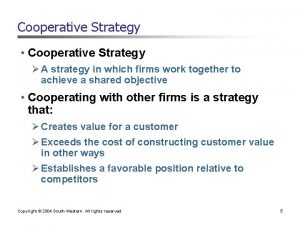Chapter 9 Cooperative Strategy Michael A Hitt R















- Slides: 15

Chapter 9 Cooperative Strategy Michael A. Hitt R. Duane Ireland Robert E. Hoskisson © 2000 South-Western College Publishing Ch 9 -1

Strategic Inputs Chapter 2 External Environment Strategic Intent Strategic Mission Chapter 3 Internal Environment Strategy Implementation Chapter 4 Business-Level Strategy Chapter 5 Competitive Dynamics Chapter 6 Corporate-Level Strategy Chapter 10 Corporate Governance Chapter 11 Structure & Control Chapter 7 Acquisitions & Restructuring Chapter 8 International Strategy Chapter 9 Cooperative Strategies Chapter 12 Strategic Leadership Chapter 13 Outcomes Strategic Actions Strategy Formulation The Strategic Management Process Feedback Entrepreneurship & Innovation Strategic Competitiveness Above Average Returns Ch 9 -2

Strategic Alliances Firm A Partnerships between firms where their Firm B Resources Capabilities are combined to pursue mutual interests to Core Competencies Develop Manufacture Distribute Goods Services Ch 9 -3

Types of Strategic Alliances Joint Venture Independent firm is created by the joining assets from two other firms where each contributes 50% of the total Example: Dow Corning from Dow Chemical and Corning Inc. Equity Strategic Alliance Partnership where the two partners do not own equal shares Example: Chrysler and Mitsubishi Automotive Non-Equity Strategic Alliance Contract is given to supply, produce or distribute a firm’s goods or services (without equity sharing) Example: Chrysler’s supplier network Ch 9 -4

Reasons for Alliances by Market Type Slow Cycle Market Standard Cycle Market Fast Cycle Market Gain access to a restricted market Establish franchise in a new market Maintain market stability Gain market power Gain access to complementary resources Overcome trade barriers Meet competitive challenge Pool resources for large projects Learn new business techniques Increase speed of product, service or market entry Maintain market leadership Form an industry technology standard Share risky R&D expenses Overcome uncertainty Ch 9 -5

Types of Strategic Alliances Complementary Alliances Business. Level Competition Reduction Alliances Competition Response Alliances Uncertainty Reduction Alliances Corporate. Level Diversification Alliances Synergistic Alliances Franchising Ch 9 -6

Types of Business-Level Strategic Alliances Complementary Strategic Alliances Supplier Value Chain Buyer Value Chain Partnerships that build on the complementarities among firms that make each more competitive Vertical Alliance Include distribution, supplier or outsourcing alliances where firms rely on upstream or downstream partners to build competitive advantage Example: Japanese manufacturers rely on close relationships among suppliers to implement Just-In-Time inventory systems Ch 9 -7

Types of Business-Level Strategic Alliances Complementary Strategic Alliances Used to increase the strategic competitiveness of the partners Supplier Value Chain Buyer Value Chain Horizontal Alliance Example: Product development agreements between Microsoft and Dreamworks SKG or Joint ventures between BMG Entertainment and Universal Music Ch 9 -8

Types of Business-Level Strategic Alliances Competition Reduction Strategies Avoiding competition by using tacit collusion such as price fixing Example: OPEC petroleum cartel Competition Response Strategies Firms join forces to respond to a strategic action of another competitor Example: Direc. TV has agreement with Time Warner for exclusive programming Uncertainty Reduction Strategies Alliances can be used to hedge against risk and uncertainty Example: ATT acquires Teleport, a provider of telecommunications services to business customers Ch 9 -9

Types of Corporate-Level Strategic Alliances Diversifying Alliances Allows a firm to expand into a new product or market area with an acquisition Example: Samsung Group joins with Nissan to build new autos Synergistic Strategic Alliances Create economies of scope between two or more firms, creating synergy across multiple businesses between firms Example: Sony shares development with many small firms Franchising Allows firms to grow and relatively strong centralized control without significant capital investments Example: Mc. Donald’s or Century 21 Ch 9 -10

International Cooperative Strategies Allows risk sharing by reducing financial investment Host partner knows local market and customs However. . International alliances can be difficult to manage due to differences in management styles, cultures or regulatory constraints Must gauge partner’s strategic intent so they do not gain access to important technology and become a competitor Ch 9 -11

Network Strategies Network strategies involve a group of interrelated firms that work for the common good of all Example: Japanese keiretsus or U. S. R&D consortia Stable Networks The three types of networks: Dynamic Networks Internal Networks Ch 9 -12

Network Strategies Stable network Long term relationships that often appear in mature industries with largely predictable market cycles Example: NIKE’s relationships with suppliers and distributors Dynamic network Arrangements that evolve in industries with rapid technological change leading to short product life cycles Example: Apple computer and Sharp electronics Internal network Management system used to coordinate a global web of suppliers and customers Example: Asea Brown Boveri’s network Ch 9 -13

Competitive Risks with Cooperative Strategies While cooperative systems can offer many advantages, there also significant risks associated with them Poor contract development Misrepresentation of partners’ competencies Failure of partners to make complementary resources available Being held hostage through specific investments made with partner Misunderstanding a partner’s strategic intent Ch 9 -14

Managing Risks in Cooperative Strategies Competitive Risks * Inadequate contracts Risk and Asset Management Approaches * Misrepresentation * Detailed of competencies * Partner fails to use complementary resources * Holding alliance partner’s specific investments hostage Outcome Value Creation contracts and monitoring * Developing trusting relationships Ch 9 -15
 Carrie cullen
Carrie cullen Kom hitt
Kom hitt Corporate level cooperative strategy
Corporate level cooperative strategy Corporate level cooperative strategy
Corporate level cooperative strategy Cooperative strategy in strategic management
Cooperative strategy in strategic management Porter strategy and the internet
Porter strategy and the internet Strategy and the internet
Strategy and the internet Corporate strategy and business strategy
Corporate strategy and business strategy Multi domestic strategy
Multi domestic strategy Chase strategy adalah
Chase strategy adalah Global operations strategy options
Global operations strategy options Aligning hr strategy with business strategy
Aligning hr strategy with business strategy Porter’s diamond of national advantage
Porter’s diamond of national advantage The strategy making strategy executing process
The strategy making strategy executing process Strategy formulation and implementation
Strategy formulation and implementation Listening strategies activities
Listening strategies activities



























